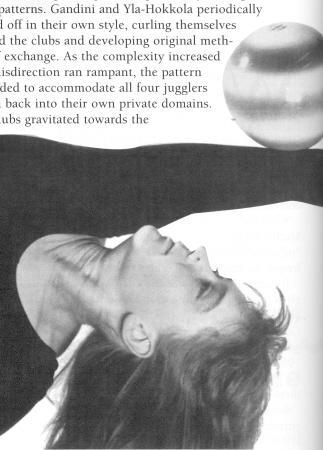
Precise manipulation is at the heart of the philosophy of the Gandini Project (Aidan Kelly photo). |
Page 20 Winter 1993-94
|
Gandini Project
Physically,
this is accomplished by giving in to the catches, letting them
take the arm to the next position rather than stopping the motion
short at the wrist. One's whole body becomes sensitive to the
catch and responds to it.
"Some
jugglers feel that the juggling doesn't go on long enough - that
there are too many carries," Gandini explained, "but for
us this is necessary to extend the movement."
For
that matter, dancers might question why the hand must constantly
return to the catching position at all.
The
Gandinis devoted a year to developing the work, rehearsing about
four hours a day, taking class in the morning, thinking about it
and discussing it the rest of
the time. The show premiered at the Lilian Bailis Theater in
London and then moved on with the help of a bank loan to the
Edinburgh Fringe Festival as part of Continental Shift, the city's
first movement-oriented venue. While it was expertly performed and
received excellent press notices, the show caused some controversy
among the other acts. "One street juggler said we were at
opposite ends of the spectrum in terms of our performance
values," recalled Gandini, "and I agreed with him. The
other shows were comedy-oriented and based on the personality of
the performers."
The
Gandinis intentionally avoid dramatic expression in an attempt to
communicate ideas and emotions through their gestures and
choreography.
Ironically,
for all its abstractions the piece resembles a traditional street
show in several aspects. The performers nonchalantly walk onto
the stage and begin setting up their props, which define the space
for the rest of the program. The costuming is sparse, though
typical of modern dance: practice clothes, a random collection of
plain sweat pants and t-shirts. However, what follows is certainly
not the usual Covent Garden street juggling fare.
Fortunately
for those of us who missed the show in Edinburgh, the Gandinis
performed a slightly shortened version in the gym at the Leeds
European Convention last summer. As jugglers surrounded the square
pitch and a very faint bubbling of music began in the background,
the
As
the first juggler entered alone with a red ball, he became a
human dewdrop, using subtle gestures and movements to create an
atmosphere of complete solitude with the ball. The skills did not
center around manipulation or control of an object, but seemed
simply a form of listening to the ball and beginning a peaceful
and playful dialogue with it, in the way a dancer gently makes
contact with his or her body before the dance. When the other
joined in, the piece took on a more mechanical feeling which
continued on and off throughout, each person absorbed in an
individual task.
Yla-Hokkala
first enters with a rope, coiling and twirling it until it
undulates like a lightning bolt around her impervious stance. The
zig-zagging of the rope seems to set the geometrical pattern for
the rest of the piece. The performers follow invisible tracks
across the floor, interacting when the paths of their designs
happen to cross. The patterns evolved through experimentation,
with choreographer Clarke setting an arbitrary structure such as
an "H" shape for the performers to follow. This method
reinforces the sense of randomness and chance which pervade the
work and ultimately become themes in themselves.
The
connection of these elements to modern life and the politics of
art is revealed primarily through the soundtrack, a continuous
monologue taken from the works of the late composer John Cage.
Sentence fragments like "art is like a complaint - just as
good" and "moveable entities flipping" create an
intriguing and sometimes puzzling dichotomy with the juggling
which viewers are left to interpret for themselves.
Art
seemed to mimic life as the performers began walking along their
designated paths, impersonally tossing clubs in basic patterns.
Gandini and Yla-Hokkola periodically zipped off in their own
style, curling themselves drawn
back into their own private domains. |

Precise manipulation is at the heart of the philosophy of the Gandini Project (Aidan Kelly photo). |